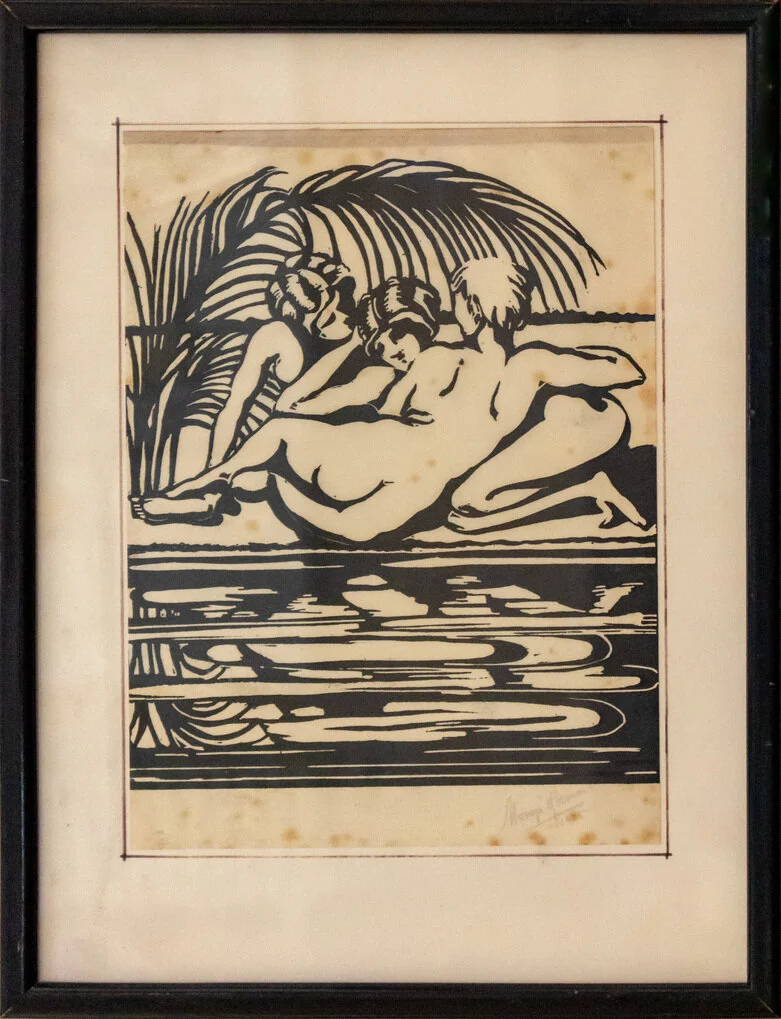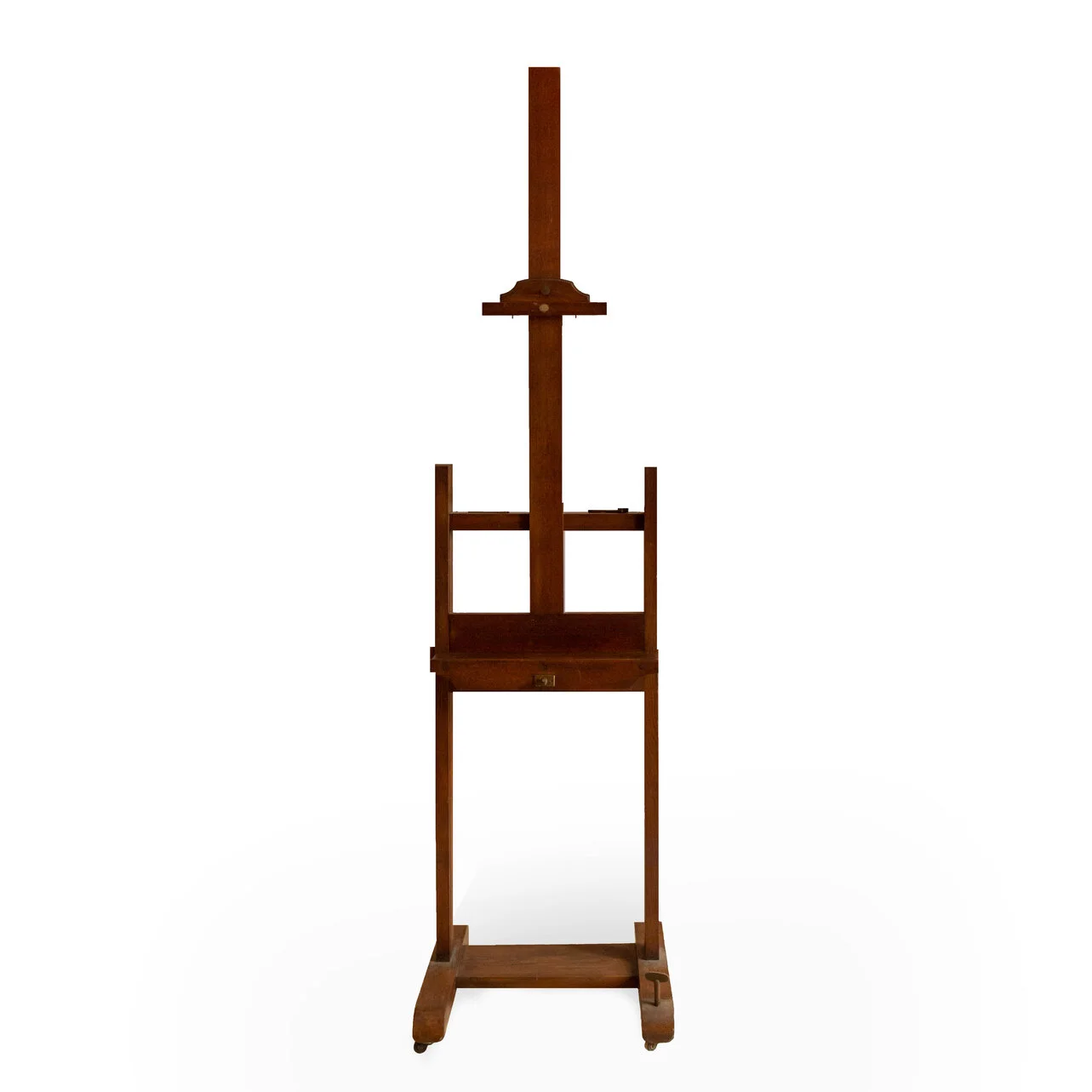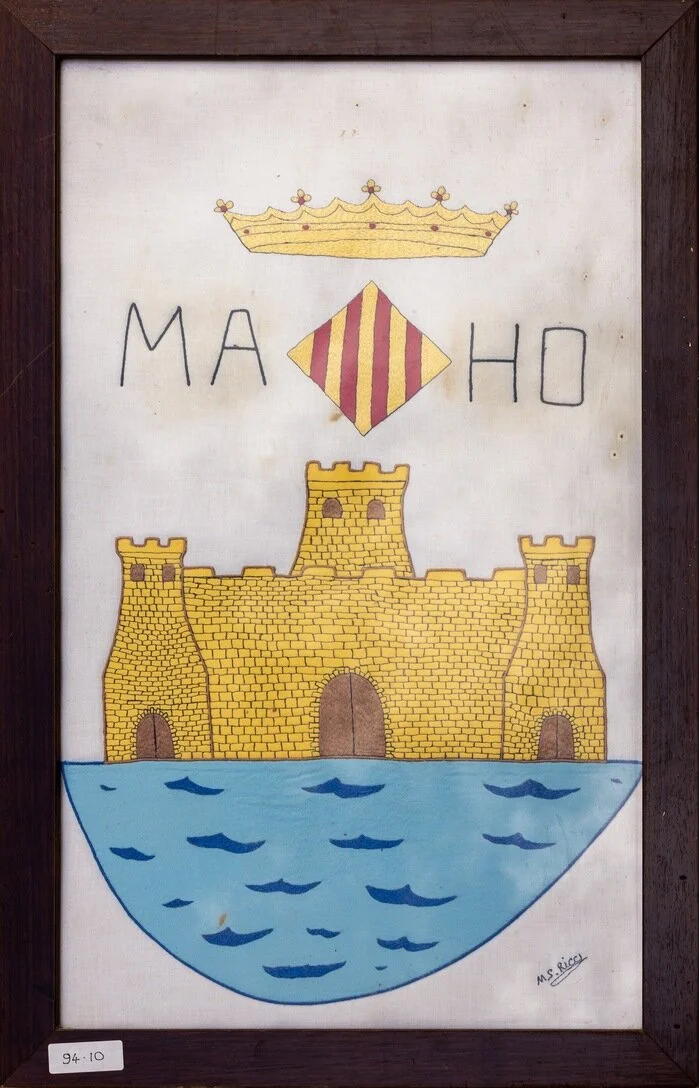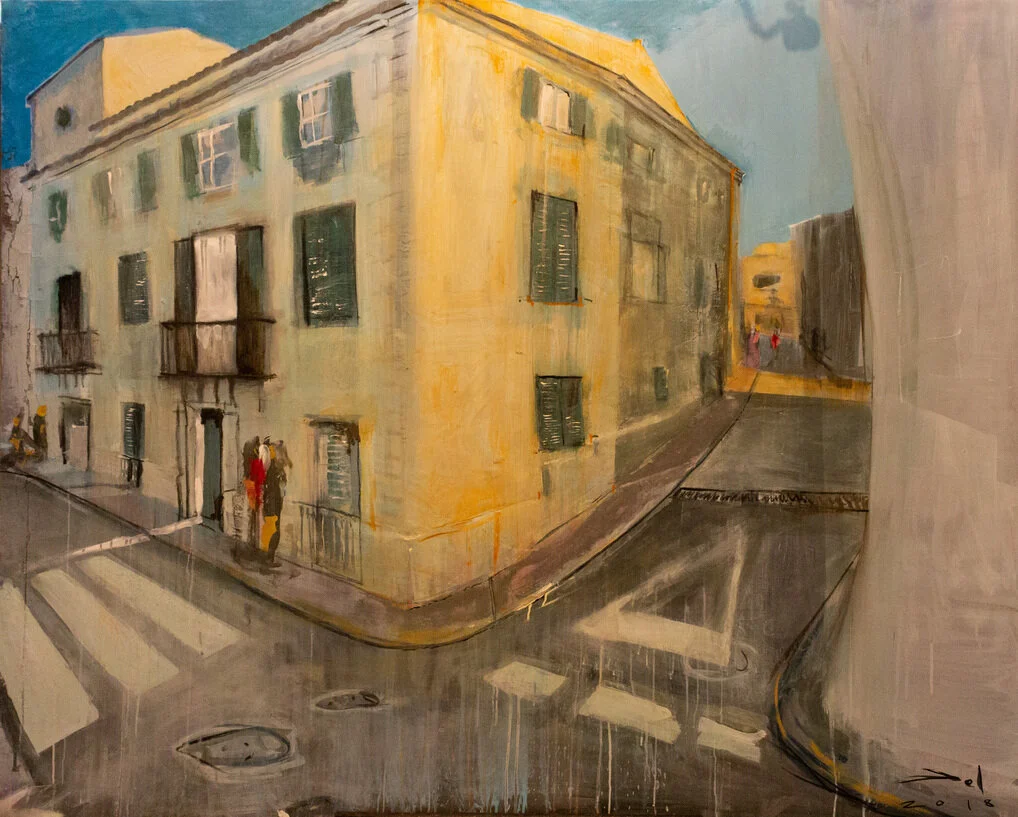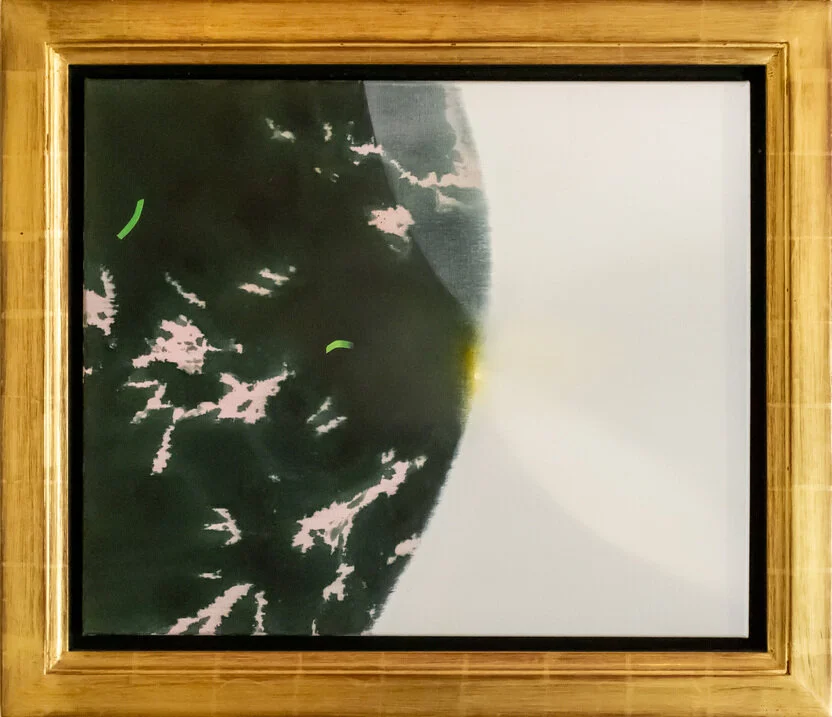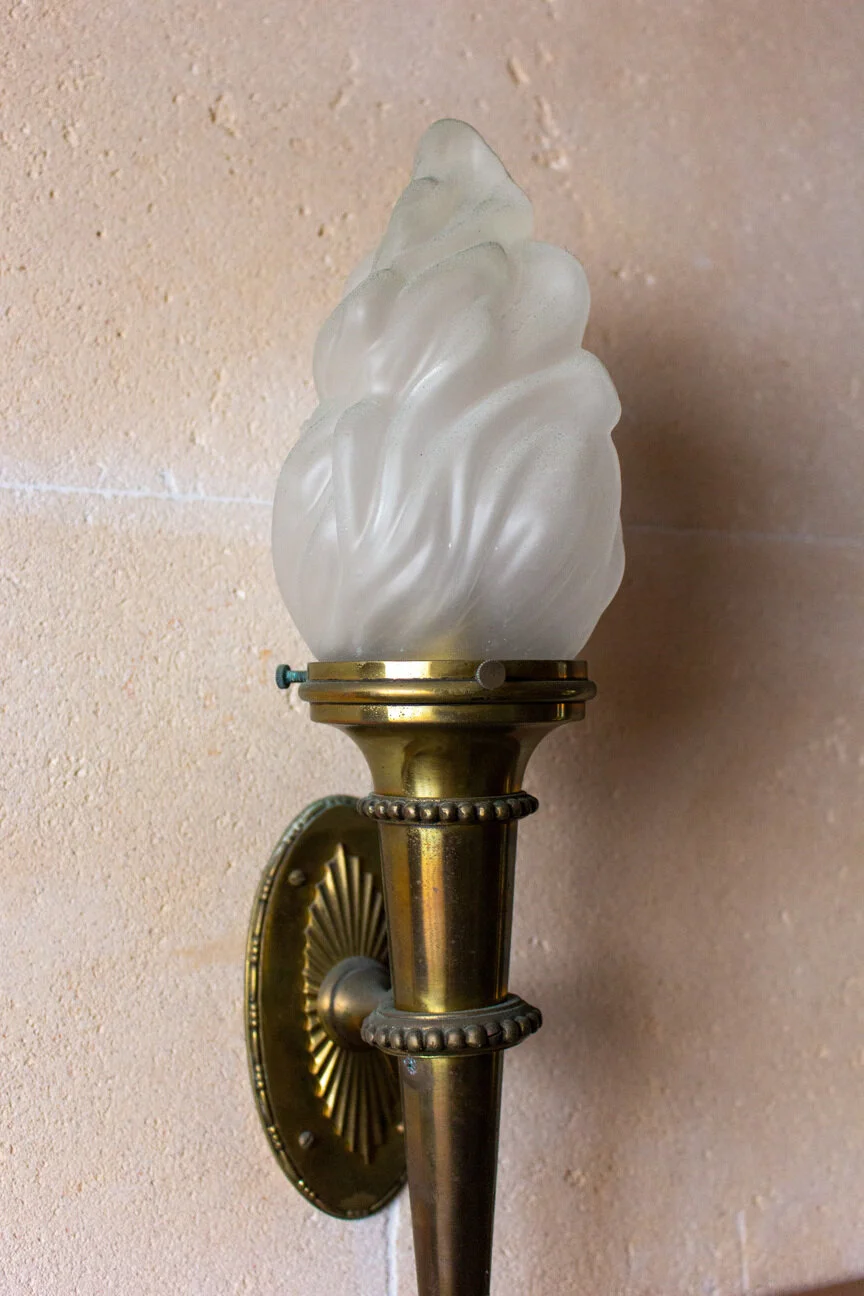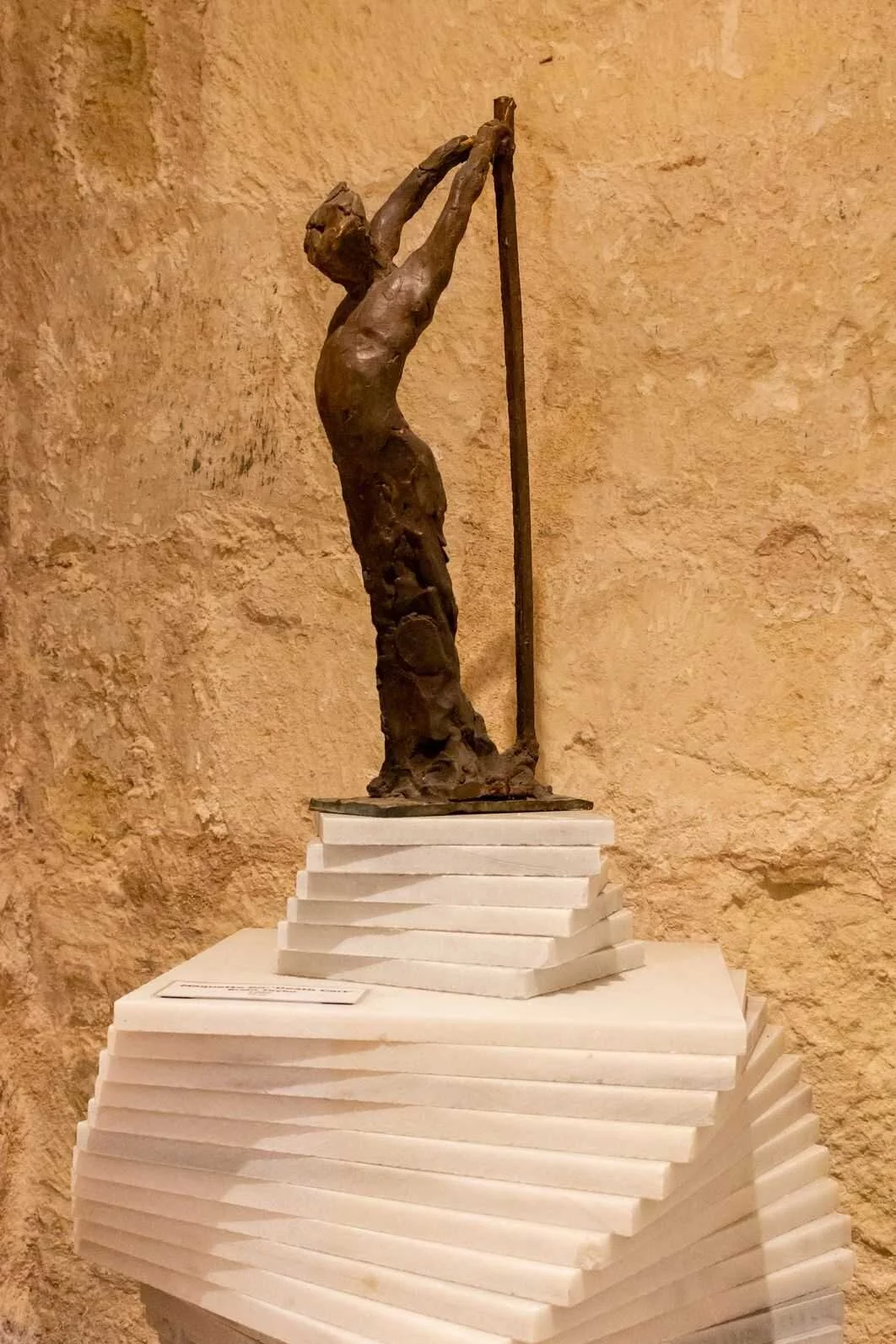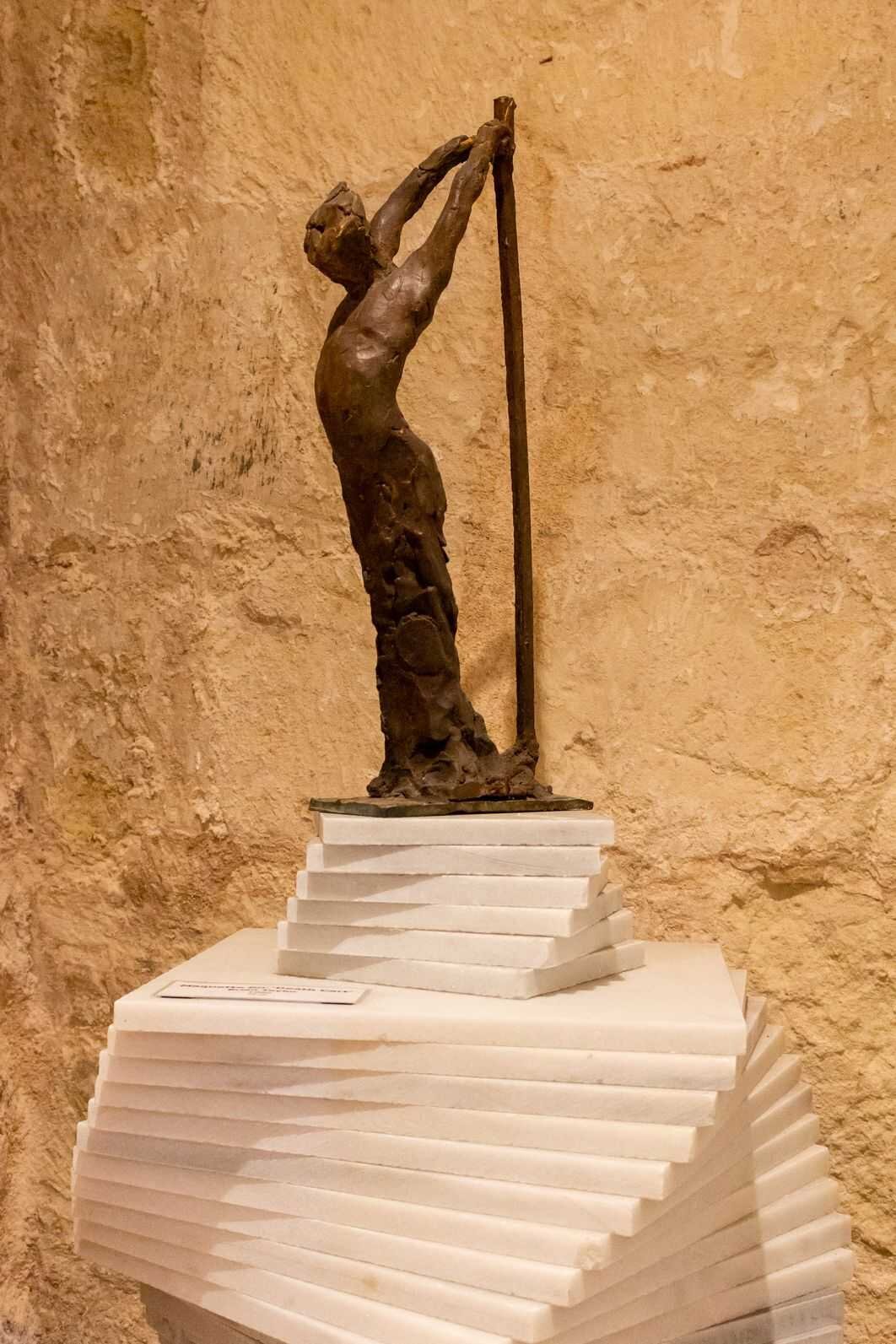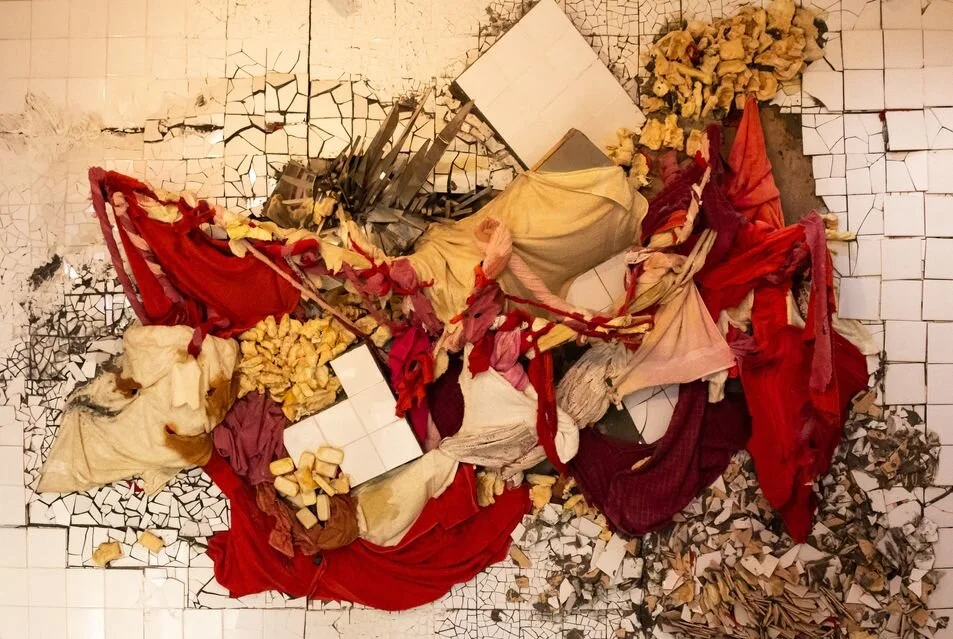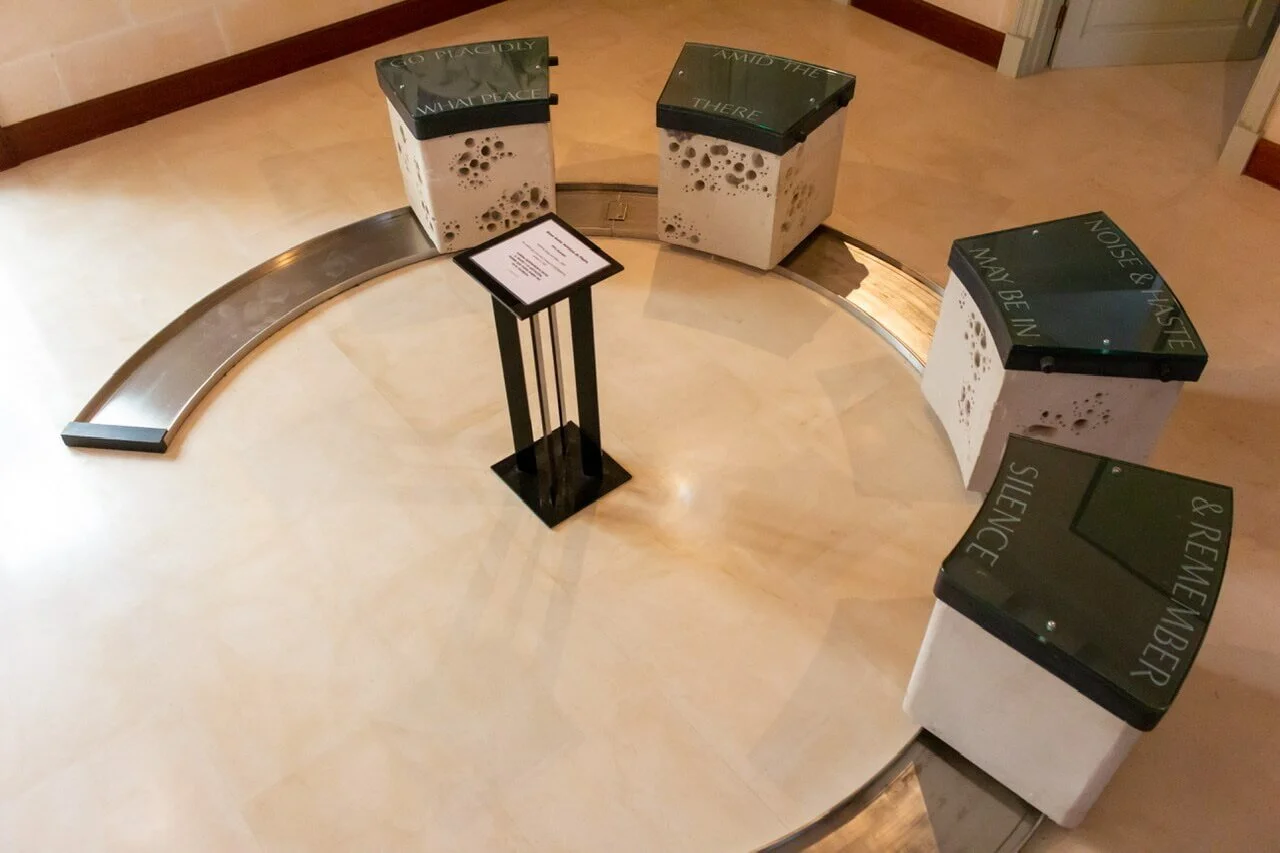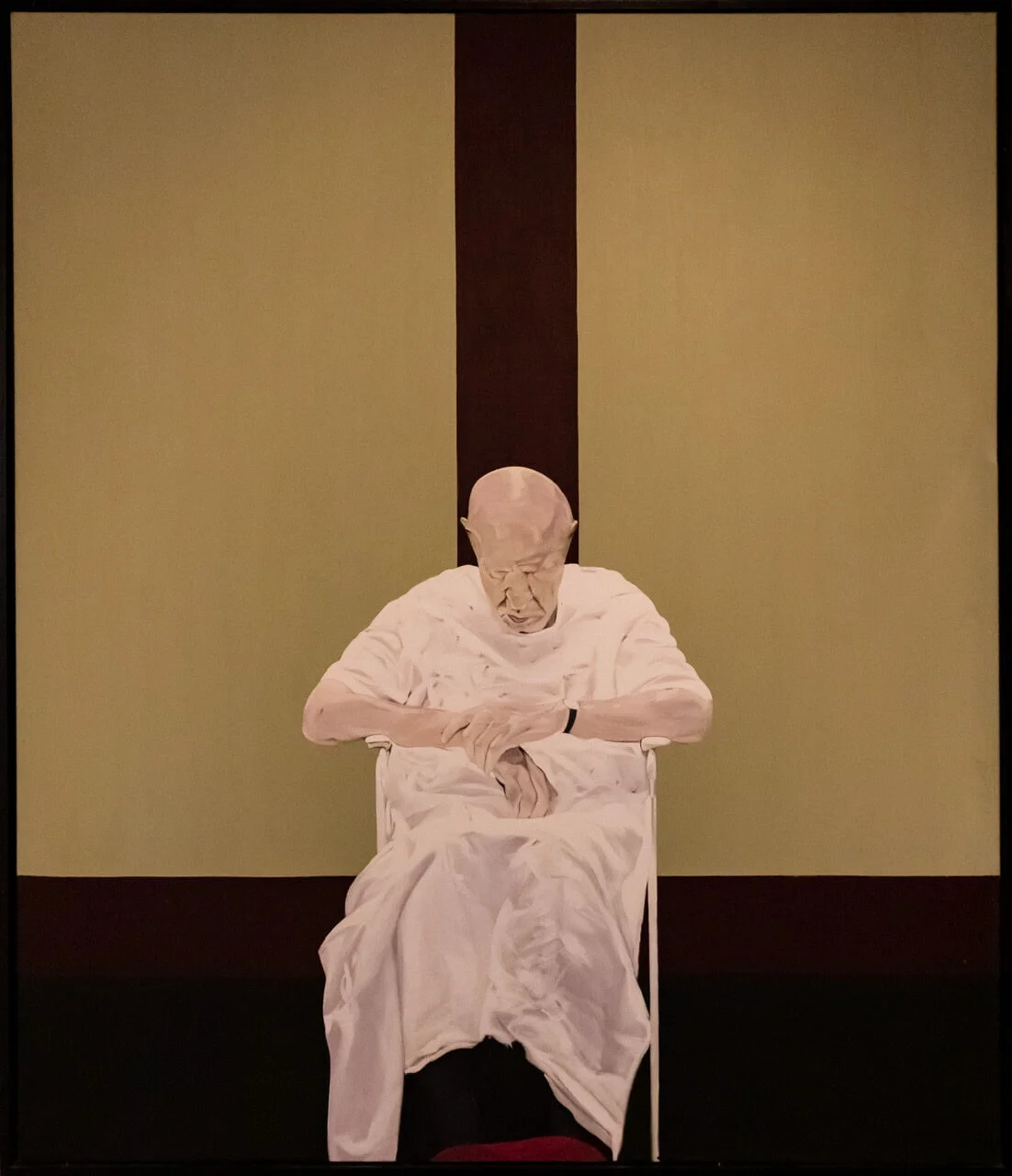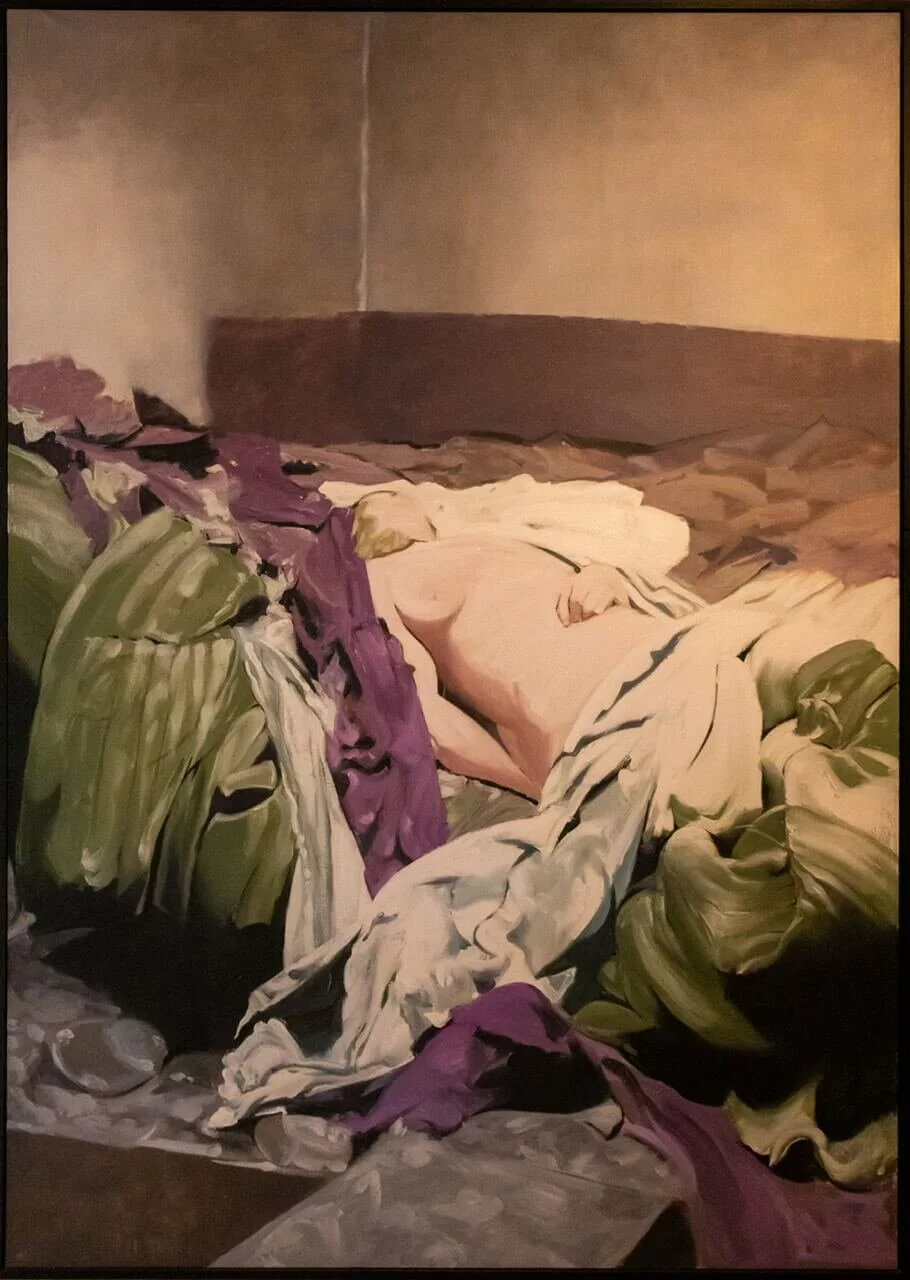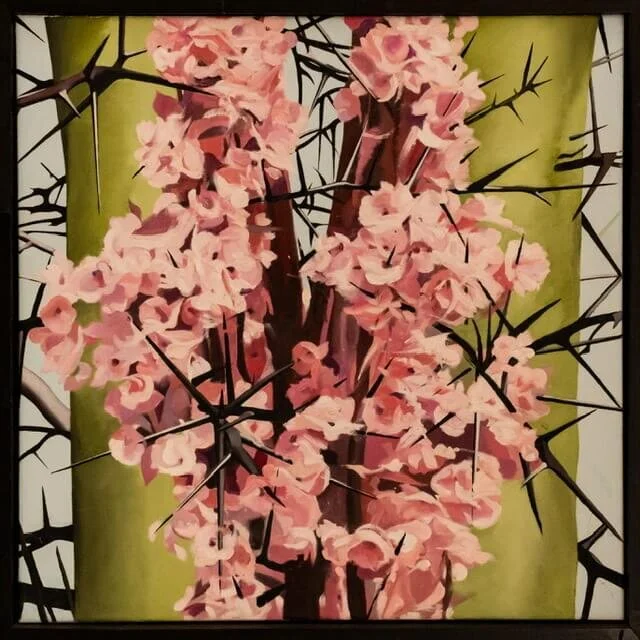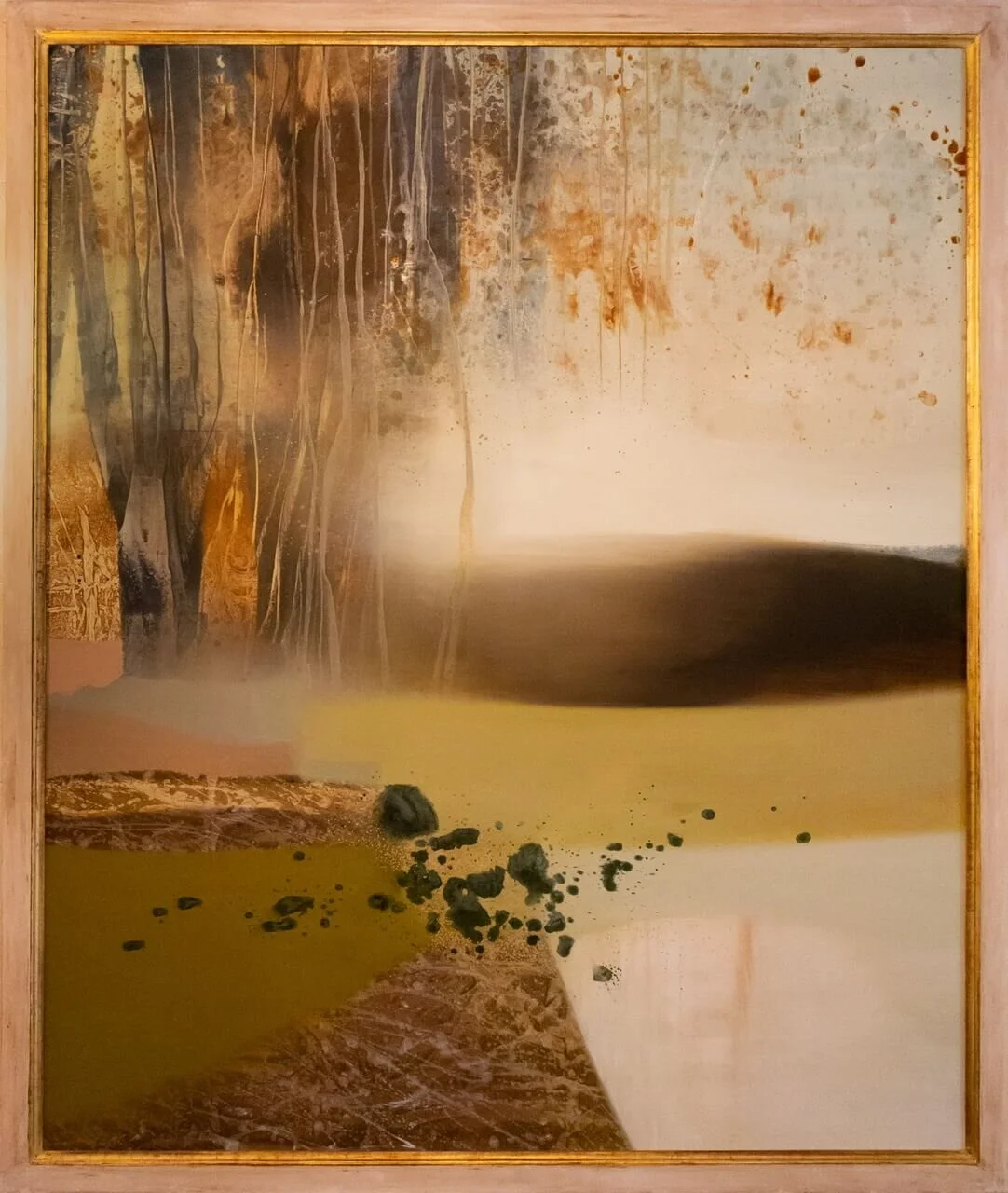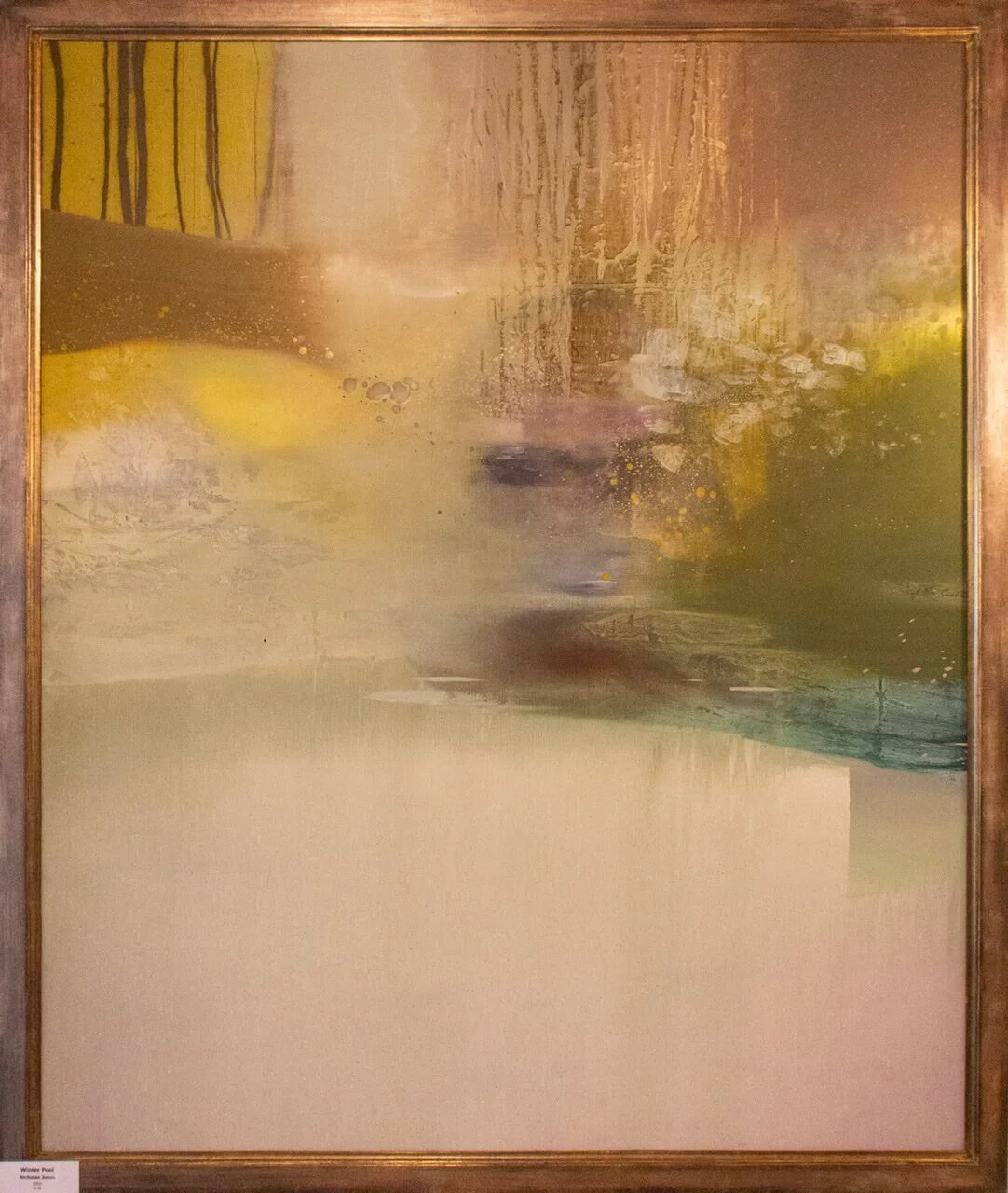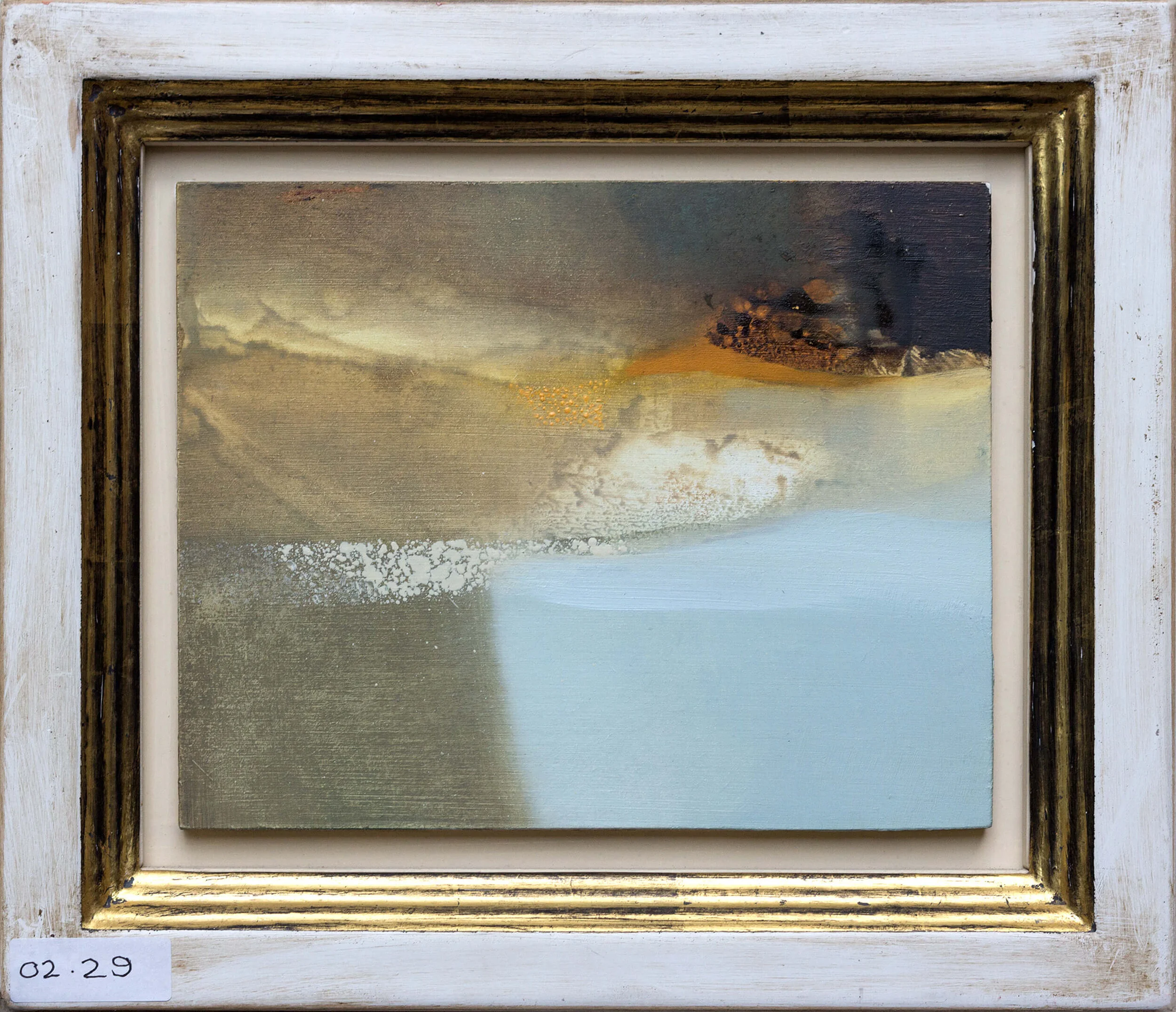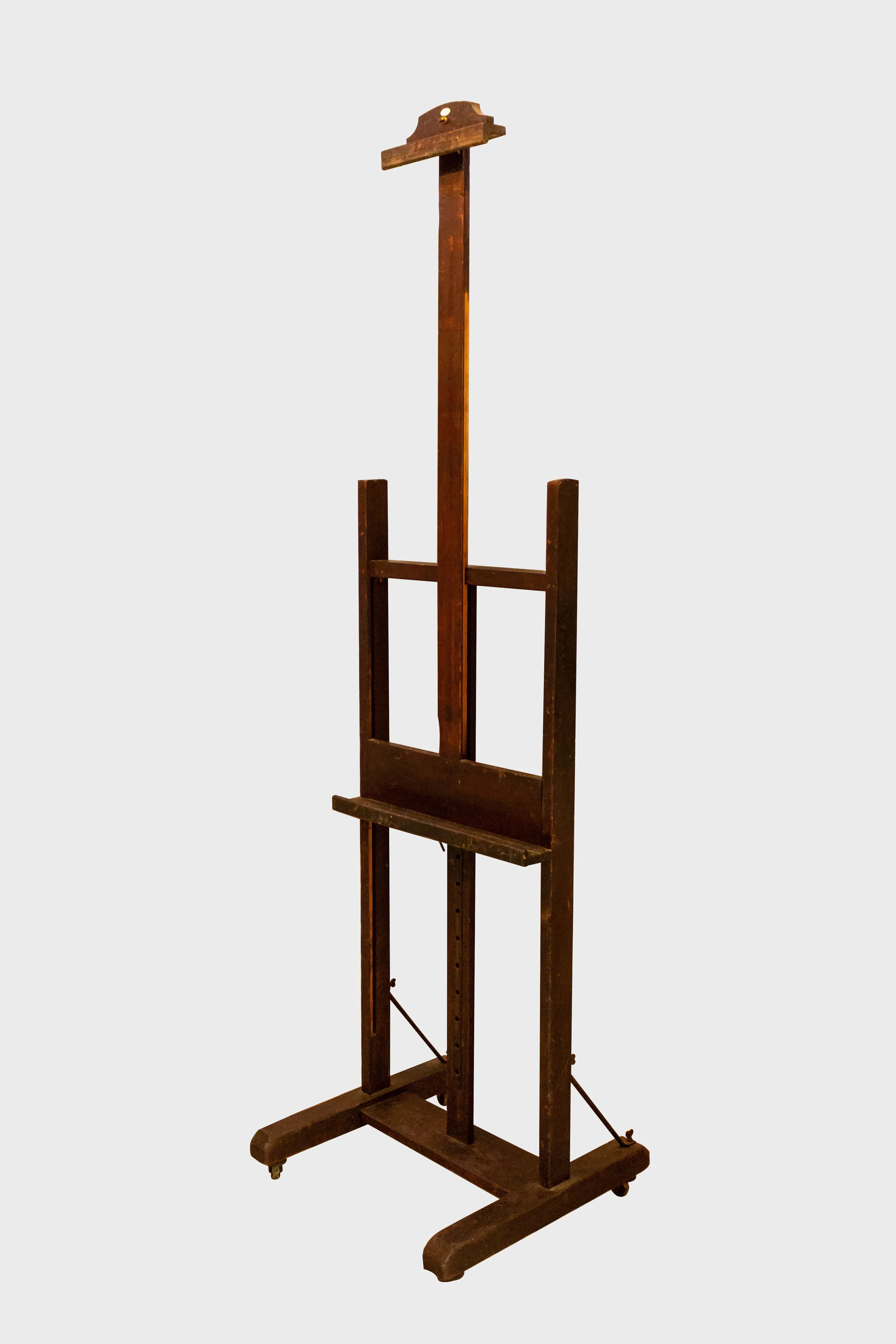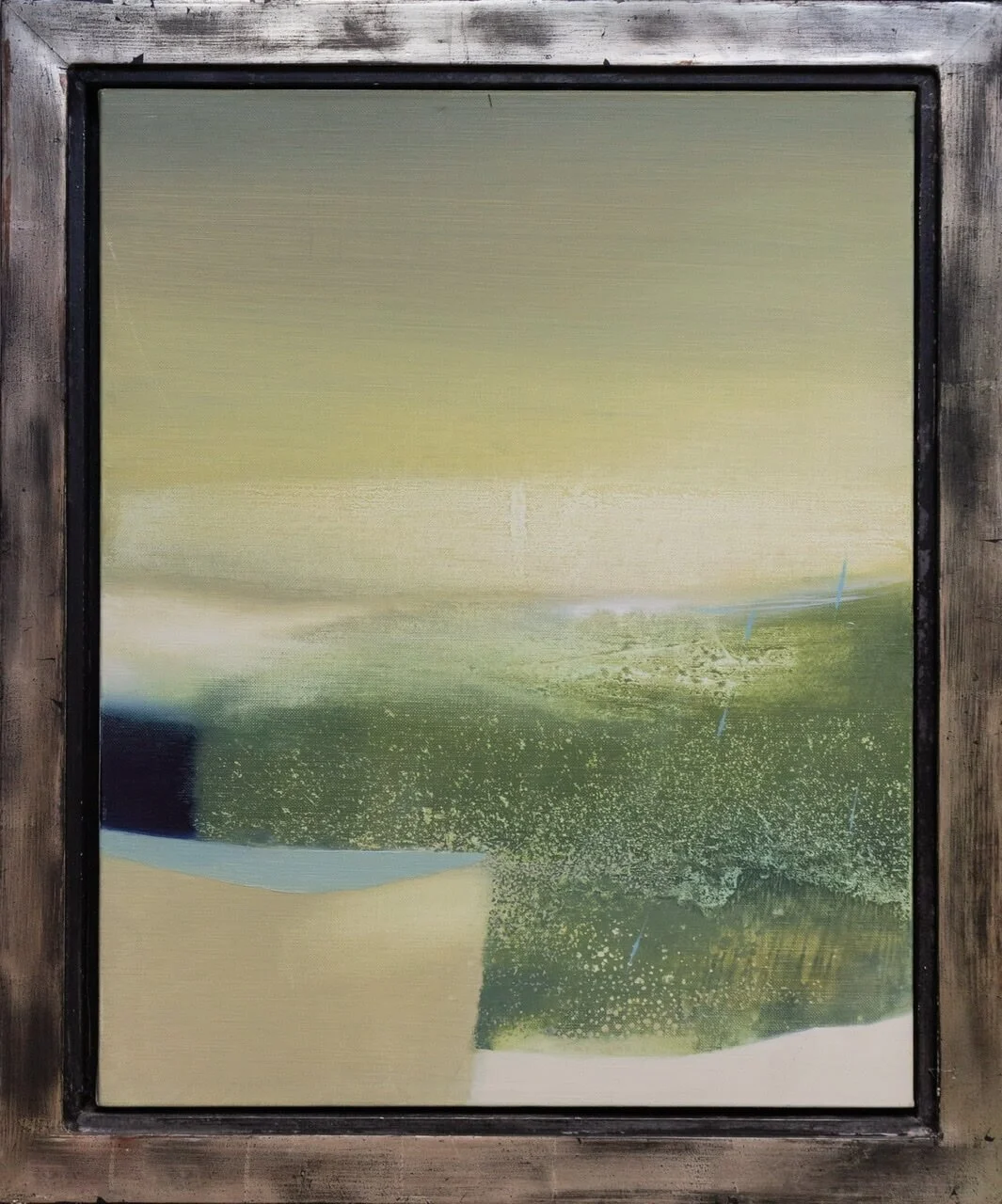97.12 Lying figures
English
Catalogue number 97.12
A black and white woodcut by Mary(?) Forman, signed and dated 1925, framed. 25 cm. high by 19 cm. wide.
Bought from Julie Collino (see 87.04) in October 1997, this strongly designed Art Deco picture of three intertwined female figures on the bank of a pool or river, with a fronded tree in the background. The artist’s signature unfortunately is barely legible.
A twentieth century interpretation of the ‘Three Graces’ of Greek mythology?
Spanish
Figuras yacentes
Número de catálogo 97.12
Un grabado en blanco y negro de Mary (?) Forman, firmado y fechado en 1925, enmarcado. Mide 25 cm de alto por 19 cm de ancho.
Comprada a Julie Collino (ver 87.04) en octubre de 1997, esta imagen Art Deco de potente diseño de tres figuras femeninas entrelazadas en la orilla de una piscina o río, con un árbol con frondas en el fondo. Desafortunadamente, la firma de la artista es apenas legible.
¿Una interpretación del siglo XX de las "Tres Gracias" de la mitología griega?
96.02 Oak easel
English
Catalogue number 96.02
English, early twentieth century, made from oak, sold by Roberson and Co., London. 250 cm. high by 55 cm. wide by 55cm. deep.
This is a nicely made oak gallery easel, with brass fittings and a long wooden screw giving considerable height adjustment. It has a brass label reading “Roberson and Co. 99, Long Acre, London”. As a supplier of artist’s materials, Charles Roberson and Co. was founded in 1810 and is still in existence today. The Company’s fascinating history is well described on its website www.robco.co.uk/history.html For anyone interested in the role and importance of the art material supplier (or ‘colourman’) to the artistic community, the detailed records of the materials and techniques of nineteenth and early twentieth century artists who were customers of Roberson are contained in the Roberson archives at the Fitzwilliam Museum. See www.hki.fitzmuseum.com.ac.uk/archives/roberson
We bought this from Apollo Antiques, The Saltisford, Warwick in July 1996.
Spanish
Caballete del artista
Número de catálogo 96.02
Inglés, de principios del siglo XX, fabricado en roble por Roberson and Co., Londres. Mide 250 cm de alto por 55 cm de ancho por 55 cm de fondo.
Este es un caballete de roble muy bien hecho, con accesorios de latón y un tornillo de madera largo que proporciona un ajuste de altura considerable. Tiene una etiqueta de latón que dice "Roberson y Co. 99, Long Acre, Londres".
Como proveedor de materiales para artistas, Charles Roberson and Co. Se fundó en 1810 y todavía existe en la actualidad. La fascinante historia de la compañía está bien descrita en su sitio web www.robco.co.uk/history.html.
Los materiales y técnicas de los artistas del siglo XIX y principios del XX que eran clientes de Roberson se encuentran en los archivos de Roberson en el Museo Fitzwilliam. Ver www.hki.fitzmuseum.com.ac.uk/archives/roberson
Lo compramos en Apollo Antiques, The Saltisford, Warwick en julio de 1996.
94.10 Mahon Crest
English
Catalogue number 94.10
Needlework on fine linen, autographed by M S Ricci, framed, probably from the 1930’s. 65 cm. High by 40 cm. Wide.
This is a fairly crude representation of the coat of arms of the city of Mahon, done in needlework on a plain white background, by someone with the unusual surname of Ricci (possibly a schoolchild or student?). It contains the familiar three-towered fortification over the sea, and the red and yellow vertically striped diamond-shaped ‘flag’. Different from the present-day coat of arms is the crown at the top – does this signify an earlier version of the crest? If so, what date? And another question – why are only the letters MAHO used, even in today’s versions?
Jane acquired this, and I have no record, nor can I remember, where it came from. Probably the Mestral re-cycling centre.
Spanish
Escudo de Mahón
Número de catálogo 94.10
Costura en lino fino, autografiada por M. S. Ricci, enmarcada, probablemente de la década de 1930. Mide 65 cm de alto por 40 cm de ancho.
Esta es una representación bastante tosca del escudo de armas de la ciudad de Mahón, hecho en costura sobre un fondo blanco liso, por alguien con el inusual apellido de Ricci (¿posiblemente un alumno o estudiante?). Contiene la familiar fortificación de tres torres sobre el mar y la "bandera" en forma de diamante con rayas verticales rojas y amarillas. Diferente del escudo de armas actual es la corona en la parte superior: ¿significa que esta es una versión anterior del escudo? Si es así, ¿en qué fecha? Y otra pregunta: ¿por qué solo se usan las letras MAHO, incluso en las versiones actuales?
Jane lo adquirió y no tengo registrado, ni puedo recordar, de dónde vino. Probablemente del centro de reciclaje Mestral.
88.02 Untitled
English
Catalogue number 88.02
A bas-relief cast in brass, marked Gottschalk 1/50, German, 20th Century, mounted on wood, 45cm high by 22cm wide.
This is another piece which we obtained at the Saturday afternoon Wellesbourne ‘car boot’ sale in 1988. It was the end of the afternoon, and the stall-holder clearly did not want the trouble of packing this heavy piece and taking it home, and if we paid anything at all for it, it was certainly not very much. But actually it is an interesting piece – an example of abstract relief sculpture, typical of the middle decades of the twentieth century. It’s become a good friend over the last thirty tears.
Spanish
Sin título
Número de catálogo 88.02
Bajorrelieve fundido en latón, con la marca Gottschalk 1/50, alemán, siglo XX, montado en madera. Mide 45 cm de alto por 22 cm de ancho.
Esta es otra pieza que obtuvimos en el “car boot sale” de Wellesbourne un sábado por la tarde de 1988. Era el final de la tarde, y el encargado del puesto claramente no quería la molestia de empacar esta pesada pieza y llevársela a casa, y si pagamos algo por ella, ciertamente no fue mucho. Pero en realidad es una pieza interesante, un ejemplo de escultura abstracta en relieve, típica de las décadas de mediados del siglo XX. Se ha convertido en un buen amigo en los últimas treinta años.
75.03 Mahogany Grandfather Clock
English
Catalogue number 75.03
19th Century. Unknown English maker. 63cm wide. x 274cm high. x 43cm deep.
This is another family heirloom from Jane’s maternal grandparent’s house in Banbury. It came to us in 1975 and adorned the Mill for a few years before being moved to London. It has an ornately decorated mahogany case, with glass front and sides enabling the beautifully made mercury compensated pendulum, the weights and the nine brass chime tubes to be seen. The three lead-filled brass weights drive a 3-train mechanism; one train drives the clock mechanism, one train drives the quarterly chimes and one powering the hourly chimes. The 8-day clock mechanism is regulated by the mercury jar/invar steel compensated pendulum and a ‘dead bear’ escapement. Eight of the nine tubes play the quarters (either ‘Westminster’ or ‘Whittington’) and the largest single tube chimes the hours. (Mercifully, the chiming mechanisms can be silenced!) The gilt face has elaborate foliate engravings and the basket of flowers is repeated in the inlaid wood panel at the base of the clock. The hood has three turned filials complementing the elaborately carved top, with fretwork panels to the sides and back, allowing the chimes to be better heard. There is a painted ‘rolling moon’ above the face which tells the day of the month and the phase of the moon, featuring a Dutch sailing vessel and a French chateau, giving the clock a European feel ahead of its time!
Spanish
Nº de catálogo 75.03
Reloj de caoba del abuelo, del siglo XIX, de fabricante inglés desconocido. Mide 63cm. x ancho x 274cm. x 43cm. de fondo.
Esta es otra reliquia familiar de la casa de los abuelos maternos de Jane en Banbury. Llegó a nosotros en 1975 y adornó el Molino durante unos años antes de ser trasladado a Londres. Tiene una caja de caoba ornamentada, con el frente y los laterales de cristal que permiten ver el péndulo compensado con mercurio, bellamente realizado, las pesas y los nueve tubos de latón para las campanadas. Las tres pesas de latón rellenas de plomo accionan un mecanismo de 3 trenes; un tren acciona el mecanismo del reloj, otro las campanadas trimestrales y otro las campanadas horarias. El mecanismo del reloj de 8 días está regulado por el péndulo compensado de acero con jarra de mercurio y un escape de "oso muerto". Ocho de los nueve tubos tocan los cuartos (ya sea "Westminster" o "Whittington") y el tubo más grande da las horas. (La esfera dorada tiene elaborados grabados foliados y la cesta de flores se repite en el panel de madera con incrustaciones de la base del reloj. La campana tiene tres filiales torneadas que complementan la parte superior elaboradamente tallada, con paneles calados a los lados y en la parte posterior, lo que permite escuchar mejor las campanadas. Encima de la esfera hay una "luna rodante" pintada que indica el día del mes y la fase de la luna, con un velero holandés y un castillo francés, lo que da al reloj un aire europeo adelantado a su tiempo.
18.02 Calle Isabel II nos. 15/17
English
Catalogue number 18.02
A painting, acrylics on canvas, by Menorcan artist Pol Marban (1985 - ) created in 2020. Signed, unframed. Height 130 cm. width 163 cm.
Commissioned from Pol by the Foundation in September 2018.
Spanish
Número de catálogo 18.02
Una pintura, acrílicos sobre lienzo, del artista menorquín Pol Marban (1985 - ) creada en 2020. Firmado, sin enmarcar. Alto 130 cm. ancho 163 cm.
Encargado a Pol por la Fundación en septiembre de 2018.
16.01 The Family
English
Catalogue number 16.01
A sculpture of metal and wood created by Argentinian-born artist and jewellery-maker Mauri Lavayén. Height 188 cm. width 35 cm.
Mauri Lavayén was born in the sixties in Villacarlos in Argentina. He came to Menorca at the turn of the century, and studied at the Escuela d’Arte de Menorca. He was an active participant in the art and jewellry making scene of Menorca until 2016 when he returned to Argentina, where he now lives and works. This abstract sculpture is on (permanent) loan to the Foundation courtesy of Pol Marban, in whose studio it had been left by Mauri for safe keeping!
Spanish
La familia
Número de catálogo 16.01
Escultura de metal y madera creada por el artista y joyero argentino Mauri Lavayén. Altura 188 cm. ancho 35 cm.
Mauri Lavayén nació en los años sesenta en Villacarlos, en Argentina. Llegó a Menorca a principios de siglo y estudió en la Escola d’Art de Menorca. Participó activamente en la escena del arte y la joyería de la isla hasta 2016 cuando regresó a Argentina, donde ahora vive y trabaja. Esta escultura abstracta está cedida (permanentemente) a la Fundación por cortesía de Pol Marban, en cuyo estudio la había dejado Mauri para su custodia.
08.02 The Singing Air
English
Catalogue number 08.02
Oils on canvas, painted by English artist Nicholas Jones (1965 - ) in 2007. Framed. Height 50 cm. width 60 cm.
This abstract landscape was shown at an exhibition titled ‘Grace Notes’ at the Crane Kalman Gallery (see 02.16) in March 2008, and we bought it from the artist (through the CKG) shortly thereafter in May 2008. It is one of five such paintings by Nicholas Jones, the others being 02.16 Sea Spray, 02.29 Into the Mountains, 02.39 Woodland Edge, 02.40 Winter Pool. In exhibition notes, the art critic Roger Berthout wrote :- Little wonder that Nicholas finds painting exciting. “It's like going on a journey when you don’t know what you will discover” he says. Looking at what he has brought back from these journeys, it is our pleasure to share that excitement.
Spanish
El aire cantando
Número de catálogo 08.02
Óleo sobre lienzo, pintado por el artista inglés Nicholas Jones (1965 -) en 2007. Enmarcado. Alto 50 cm. Ancho 60 cm.
Este paisaje abstracto se mostró en una exposición titulada “Grace Notes” en la Crane Kalman Gallery (ver 02.16) en marzo de 2008, y se lo compramos al artista (a través del CKG) poco después, en mayo de 2008. Es una de las cinco pinturas de Nicholas Jones, las otras son 02.16 Sea Spray, 02.29 Into the Mountains, 02.39 Woodland Edge y 02.40 Winter Pool.
En las notas de la exposición, el crítico de arte Roger Berthout escribió: “No es de extrañar que a Nicolás le parezca emocionante la pintura. "Es como emprender un viaje en el que no sabes lo que vas a descubrir", dice. Al ver lo que ha traído de estos viajes, es un placer para nosotros compartir esa emoción”.
06.04 Torchères (Wall-lights)
English
Catalogue number 06.04
Four brass wall lights with ormolu finish and moulded glass ‘flares’ made by the General Electric Company (GEC) of Magnet House, Kingsway, London, dated 1909, ‘Fleet’ model F 2015. Height 44 cm. width 16 cm. depth 20 cm.
Whilst my parents were still alive, we used to travel regularly between Warwick and the Essex coast where they lived. En route, just off the main A14 road in a little village near Stowmarket, we got to know over the years a small thriving business called the Antique Lighting Company Ltd, then located at The Old Rectory, Kennett, Suffolk. (The company has since moved to more modern premises). When it came to choosing light fittings for the entrance to the Foundation’s entrance we bought from them these four tòrcheres dating from 1909 (Electricity was first introduced to Menorca in 1892). The main reason for choosing these particular ones was that I spent most of my working life with the GEC. The original 1909 catalogue shows that the unit price at that time was £1 16 shillings.
Spanish
Número de catálogo 06.04
Cuatro apliques de latón con acabado ormolu y "bengalas" de vidrio moldeado fabricados en 1909 por la General Electric Company (GEC) de Magnet House, Kingsway, Londres. Modelo "Fleet" F 2015. Miden 44 cm de altura, 16 cm de anchura y 20 cm de fondo.
Mientras mis padres aún vivían, solíamos viajar con regularidad entre Warwick y la costa de Essex, donde vivían. En el camino, justo al lado de la carretera principal A14, en un pequeño pueblo cerca de Stowmarket, conocimos a lo largo de los años una pequeña y próspera empresa llamada Antique Lighting Company Ltd, entonces ubicada en The Old Rectory, Kennett, Suffolk (desde entonces, la empresa se ha trasladado a unas instalaciones más modernas). A la hora de elegir luminarias para la entrada de la Fundación les compramos estos cuatro tòrcheres que datan de 1909 (La electricidad se introdujo por primera vez en Menorca en 1892). La principal razón para elegir estos en particular fue que pasé la mayor parte de mi vida laboral con el GEC. El catálogo original de 1909 muestra que el precio unitario en ese momento era £ 1 y 16 chelines.
05.16 Maquette for Death Cart (arms upraised)
English
Catalogue number 05.16
A bronze study of a figure by English sculptor Brian Taylor FRBS FSPS (1935 – 2013) created in 1984. Height 52 cm. by 13 cm. by 10 cm.
Brian Taylor studied at the Slade School of Art at University College London from 1954 to 1958, and then studied and worked in Rome for several years. There is a full tribute to him, and a description of his life and work at www.briantaylorsculptor.com This bronze sculpture (one of ten) is a study for a figure that was to be part of a project which he undertook late in his life and never finished portraying ‘the death that is life’ called ‘The Death Cart’. Full of force and movement, we bought it at an exhibition of the work of British sculptors at the Royal Society of British Sculptors, 178, Old Brompton Road, London in June 2006.
Spanish
Maqueta para el Carro de la Muerte (brazos en alto)
Número de catálogo 05.16
Estudio en bronce de una figura del escultor inglés Brian Taylor FRBS FSPS (1935 - 2013) creado en 1984. Alto 52 cm por 13 cm ancho por 10 cm de fondo.
Brian Taylor estudió en la Slade School of Art del University College de Londres de 1954 a 1958, y luego estudió y trabajó en Roma durante varios años. Hay un homenaje completo hacia él, y una descripción de su vida y obra en www.briantaylorsculptor.com
Esta escultura de bronce (una de las diez) es un estudio de una figura que iba a ser parte de un proyecto que emprendió al final de su vida y que nunca terminó retratando 'la muerte que es vida', llamada “El carro de la muerte”. Lleno de fuerza y movimiento, lo compramos en una exposición colectiva de diversos escultores británicos en la Royal Society of British Sculptors, en Old Brompton Road 178, Londres, en junio de 2006.
05.08 The Massacre of the Innocents
English
Catalogue number 05.08
A mixed-media relief by British-born Israeli artist Peter Jacob Maltz (1973 -) created in 2004/5. Height 244 cm. Width 366 cm. Depth 70 cm. It references Peter Paul Rubens’ painting of the biblical event.
The full title of this work is ‘Lying in the bath thinking of the Massacre of the Innocents’. Peter Maltz studied sculpture at the Royal College of Art in London and graduated in 2005 This monumental piece was a part of his degree show and we bought it from him at the show in June 2005. He came to Menorca later that year to help with its installation. He wrote at the time :- ‘This large relief is made of bathroom items such as tiles, soap, broken mirrors and towels. My purpose was to transform an everyday domestic event into a monumental scene. Combining these banal materials I formed a dramatic composition that literally broke through the surface, appearing as if physical form has burst through from behind the pictorial plane. I referred to a painting titled ‘The Massacre of the Innocents’ painted by Rubens (which is hung at the National Gallery, London). The painting depicts a scene relating to the massacre of the innocents from the Bible. Rubens used dramatic and sophisticated composition. He also painted exposed flesh. These elements inspired me to translate the painting into an abstract relief. I used the towels as flesh, the soap as fat and skin. The tiles were used as a mediator between the inside to the outside, between fantasy and reality, decorative to expressive and static to dynamic’.
He now lives and works in Tel Aviv. See also 06.03 ‘Mother washing child’.
Spanish
La masacre de los inocentes
Número de catálogo 05.08
Un relieve de técnica mixta del artista israelí nacido en Gran Bretaña Peter Jacob Maltz (1973 -), creado en 2004/5. Altura 244 cm. Anchura 366 cm. Fondo 70 cm. Hace referencia a la pintura de Peter Paul Rubens del evento bíblico.
El título completo de esta obra es "Tumbado en el baño pensando en la Masacre de los Inocentes". Peter Maltz estudió escultura en el Royal College of Art de Londres y se licenció en 2005. Esta pieza monumental formaba parte de su exposición de grado y se la compramos en la exposición de junio de 2005. Vino a Menorca ese mismo año para ayudar con su instalación. En aquel momento, escribió: “Este gran relieve está hecho de artículos de baño como azulejos, jabón, espejos rotos y toallas. Mi propósito era transformar un evento doméstico cotidiano en una escena monumental. Combinando estos materiales banales formé una composición dramática que literalmente rompió la superficie, pareciendo como si una forma física hubiera irrumpido detrás del plano pictórico. Me referí a un cuadro titulado "La masacre de los inocentes" pintado por Rubens (que está colgado en la National Gallery de Londres). La pintura representa una escena relacionada con la masacre de los inocentes de la Biblia. Rubens utilizó una composición dramática y sofisticada. También pintó carne expuesta. Estos elementos me inspiraron a traducir la pintura en un relieve abstracto. Usé las toallas como carne, el jabón como grasa y piel. Los azulejos se utilizaron como mediadores entre el interior y el exterior, entre la fantasía y la realidad, de decorativo a expresivo y de estático a dinámico”.
Ahora vive y trabaja en Tel Aviv. Ver también 06.03 "Madre lavando al niño".
04.11 The bench
English
Catalogue number 04.11. A sculpture of 4 stone seats on a circular runway, by English sculptor Daniel Hewlett, created in 2003/4. Diameter 270 cm. Height 51 cm.
Dan graduated from the City and Guilds of London School of Art, Kennington Park Road, London, and this sculpture was part of his degree show in June 2004. We bought it from him after the show.
Spanish
Número de catálogo 04.11. Escultura de 4 asientos de piedra en una pista circular, del escultor inglés Daniel Hewlett, creada en 2003/4. Diámetro 270 cm. Altura 51 cm.
Dan se graduó en la City and Guilds of London School of Art, Kennington Park Road, Londres, y esta escultura formó parte de su exposición de fin de carrera en junio de 2004. Se la compramos después de la exposición.
03.06 Seated Figure in White Gown
English
Catalogue number 03.06. Painted in 2003. Height 215 cm. by 183 cm. wide.
Bought with the help of Greg Williams at the Pilgrim Gallery, then at 58, Lamb’s Conduit Street, London, at a solo exhibition by Neil called ‘Sex, Death and Ageing’ in September 2003. Neil Stokoe was born in 1935 in Durham, England and trained as a painter initially at the nearby Sunderland College of Art, and then at the Royal College of Art in London, where he was a contemporary of David Hockney. Asked about the influences on his painting style, he wrote:-‘ I suppose predominately its just a line of western European painting stemming from Titian, Velasquez…. All the painters that have been interested in the physical substance of paint and the way the image is actually turned out through the manipulation and the use of the paint as a very physical medium…. I suppose if there were one person that would be Francis Bacon.’ He lived in Twickenham, and we got to know him at the time of buying these paintings.
Of all the artists I have met, he was the most possessive about what he had created. He died in 2019.
Spanish
Número de catálogo 03.05. Pintado en 1994. Altura 236 cm. por 167 cm. de ancho.
Comprado con la ayuda de Greg Williams en la Pilgrim Gallery, entonces en el 58 de Lamb's Conduit Street, Londres, en una exposición individual de Neil titulada "Sex, Death and Ageing" en septiembre de 2003. Neil Stokoe nació en 1935 en Durham, Inglaterra, y se formó como pintor inicialmente en el cercano Sunderland College of Art, y luego en el Royal College of Art de Londres, donde fue contemporáneo de David Hockney. Cuando se le preguntó por las influencias de su estilo pictórico, escribió: "Supongo que se trata principalmente de una línea de pintura europea occidental que procede de Tiziano, Velázquez.... Todos los pintores que se han interesado por la sustancia física de la pintura y la forma en que la imagen se convierte en realidad a través de la manipulación y el uso de la pintura como un medio muy físico.... Supongo que si hubiera una persona sería Francis Bacon'. Vivía en Twickenham y le conocimos cuando compramos estos cuadros.
De todos los artistas que he conocido, era el más posesivo con lo que había creado. Murió en 2019.
03.05 Lying figure
English
Catalogue number 03.05. Painted in 1994. Height 236 cm. by 167 cm wide.
Bought with the help of Greg Williams at the Pilgrim Gallery, then at 58, Lamb’s Conduit Street, London, at a solo exhibition by Neil called ‘Sex, Death and Ageing’ in September 2003. Neil Stokoe was born in 1935 in Durham, England and trained as a painter initially at the nearby Sunderland College of Art, and then at the Royal College of Art in London, where he was a contemporary of David Hockney. Asked about the influences on his painting style, he wrote:-‘ I suppose predominately its just a line of western European painting stemming from Titian, Velasquez…. All the painters that have been interested in the physical substance of paint and the way the image is actually turned out through the manipulation and the use of the paint as a very physical medium…. I suppose if there were one person that would be Francis Bacon.’ He lived in Twickenham, and we got to know him at the time of buying these paintings.
Of all the artists I have met, he was the most possessive about what he had created. He died in 2019.
Spanish
Número de catálogo 03.05. Pintado en 1994. Altura 236 cm. por 167 cm. de ancho.
Comprado con la ayuda de Greg Williams en la Pilgrim Gallery, entonces en el 58 de Lamb's Conduit Street, Londres, en una exposición individual de Neil titulada "Sex, Death and Ageing" en septiembre de 2003. Neil Stokoe nació en 1935 en Durham, Inglaterra, y se formó como pintor inicialmente en el cercano Sunderland College of Art, y luego en el Royal College of Art de Londres, donde fue contemporáneo de David Hockney. Cuando se le preguntó por las influencias de su estilo pictórico, escribió: "Supongo que se trata principalmente de una línea de pintura europea occidental que procede de Tiziano, Velázquez.... Todos los pintores que se han interesado por la sustancia física de la pintura y la forma en que la imagen se convierte en realidad a través de la manipulación y el uso de la pintura como un medio muy físico.... Supongo que si hubiera una persona sería Francis Bacon'. Vivía en Twickenham y le conocimos cuando compramos estos cuadros.
De todos los artistas que he conocido, era el más posesivo con lo que había creado. Murió en 2019.
03.01 Blossom and Thorns
English
Catalogue number 03.01. Painted in 2002. Height 76 cm. by 76 cm.
Bought with the help of Greg Williams at the Pilgrim Gallery, then at 58, Lamb’s Conduit Street, London, at a solo exhibition by Neil called ‘Sex, Death and Ageing’ in September 2003. Neil Stokoe was born in 1935 in Durham, England and trained as a painter initially at the nearby Sunderland College of Art, and then at the Royal College of Art in London, where he was a contemporary of David Hockney. Asked about the influences on his painting style, he wrote:-‘ I suppose predominately its just a line of western European painting stemming from Titian, Velasquez…. All the painters that have been interested in the physical substance of paint and the way the image is actually turned out through the manipulation and the use of the paint as a very physical medium…. I suppose if there were one person that would be Francis Bacon.’ He lived in Twickenham, and we got to know him at the time of buying these paintings.
Of all the artists I have met, he was the most possessive about what he had created. He died in 2019.
Spanish
Número de catálogo 03.01. Pintado en 2002. Altura 76 cm. por 76 cm.
Comprado con la ayuda de Greg Williams en la Pilgrim Gallery, entonces en el 58 de Lamb's Conduit Street, Londres, en una exposición individual de Neil titulada "Sex, Death and Ageing" en septiembre de 2003. Neil Stokoe nació en 1935 en Durham, Inglaterra, y se formó como pintor inicialmente en el cercano Sunderland College of Art, y luego en el Royal College of Art de Londres, donde fue contemporáneo de David Hockney. Cuando se le preguntó por las influencias de su estilo pictórico, escribió: "Supongo que se trata principalmente de una línea de pintura europea occidental que procede de Tiziano, Velázquez.... Todos los pintores que se han interesado por la sustancia física de la pintura y la forma en que la imagen se convierte en realidad a través de la manipulación y el uso de la pintura como un medio muy físico.... Supongo que si hubiera una persona sería Francis Bacon'. Vivía en Twickenham y le conocimos cuando compramos estos cuadros.
De todos los artistas que he conocido, era el más posesivo con lo que había creado. Murió en 2019.
02.39 Woodland edge
English
Catalogue number 02.39
Oils on canvas, painted by English artist Nicholas Jones (1965 - ) in 2001. Signed on the back and framed. Height 183 cm. by 150 cm. wide. Bought from the Crane Kalman Gallery (see 02.16) in March 2002.
Spanish
Número de catálogo 02.39
Óleos sobre lienzo, pintados por el artista inglés Nicholas Jones (1965) en 2001. Firmado al dorso y enmarcado. Altura 183 cm. por 150 cm. de ancho. Comprado en la Galería Crane Kalman (véase 02.16) en marzo de 2002.
02.40 Winter pool
English
Catalogue number 02.40.
Oils on canvas, painted by English artist Nicholas Jones (1965 - ) in 2001. Framed. Height 183 cm. by 150 cm. wide. Bought from the Crane Kalman Gallery, (see 02.16), in March 2002.
Spanish
Número de catálogo 02.40.
Óleos sobre lienzo, pintados por el artista inglés Nicholas Jones (1965) en 2001. Enmarcado. Altura 183 cm. por 150 cm. de ancho. Comprado en la Galería Crane Kalman, (ver 02.16), en marzo de 2002.
02.29 Into the mountains
English
Catalogue number 02.29.
Oils on board, painted by English artist Nicholas Jones (1965 - ) in 2002. Framed. Height 20 cm. by 25 cm. wide. Bought at the Crane Kalman Gallery (see 02.16) in March 2002.
Spanish
Número de catálogo 02.29.
Óleos sobre tabla, pintados por el artista inglés Nicholas Jones (1965) en 2002. Enmarcado. Altura 20 cm. por 25 cm. de ancho. Comprado en la galería Crane Kalman (véase 02.16) en marzo de 2002.
01.02 Artist’s easel
English
Catalogue number 01.02.
A utilitarian studio easel, English, maker unknown in varnished timber from the nineteenth century. Height 220 cm. width 58 cm. depth 61 cm. Bought from the Warwick Vintage Antiques Centre, 36, Market Place, Warwick, in 2001. It lived in the hallway of Castle Hill House, with something always displayed on it.
Spanish
Número de catálogo 01.02.
Caballete de estudio utilitario, inglés, fabricante desconocido en madera barnizada del siglo XIX. Altura 220 cm. anchura 58 cm. profundidad 61 cm. Comprado en el Warwick Vintage Antiques Centre, 36, Market Place, Warwick, en 2001. Vivía en el vestíbulo de Castle Hill House, con algo siempre expuesto.
02.16 Sea spray
English
Catalogue number 02.16.
Oils on board, by English painter Nicholas Jones (1965 - ) painted in 2002. Framed. Height 51 cm. by 41 cm. wide.
This is the first in a series of five abstract landscapes created by Nicholas Jones, bought from the Crane Kalman Gallery, 178 Brompton Road, London. The others, all hanging in the Main Gallery are: - 02.29 Into the Mountains, 02.39 Woodland Edge, 02.40 Winter Pool, and 08.02 Thae Singing Air.
Spanish
Número de catálogo 02.16.
Óleos sobre tabla, del pintor inglés Nicholas Jones (1965 - ) pintado en 2002. Enmarcado. Altura 51 cm. por 41 cm. de ancho.
Este es el primero de una serie de cinco paisajes abstractos creados por Nicholas Jones, adquiridos en la Crane Kalman Gallery, 178 Brompton Road, Londres. Los otros, todos ellos colgados en la Galería Principal, son: - 02.29 Into the Mountains, 02.39 Woodland Edge, 02.40 Winter Pool y 08.02 Thae Singing Air.
